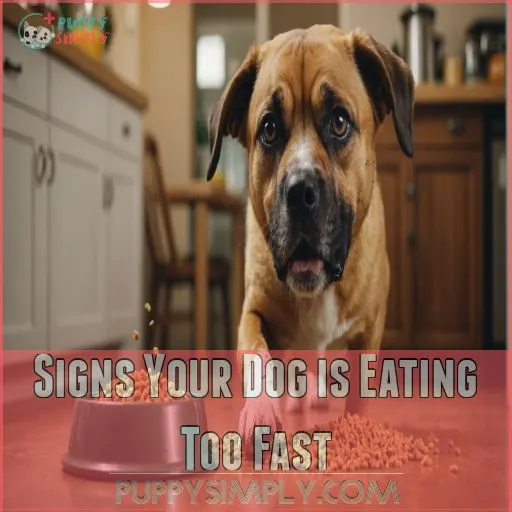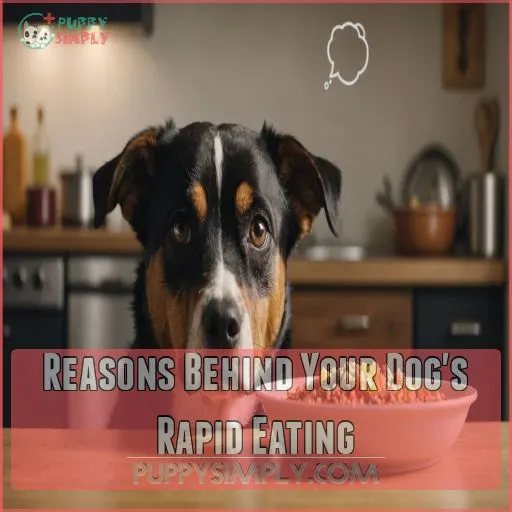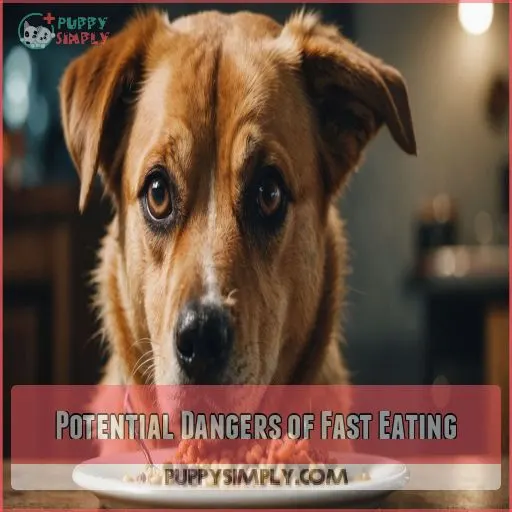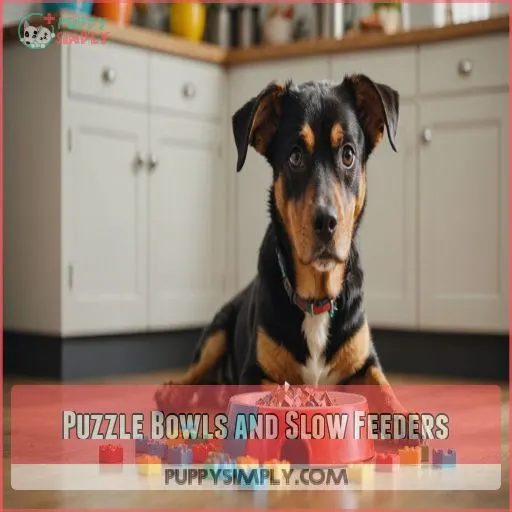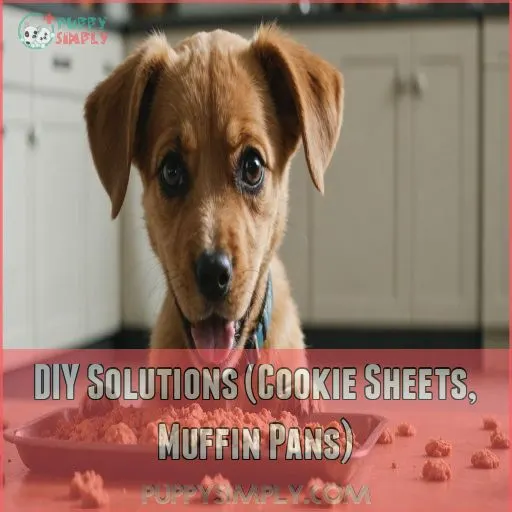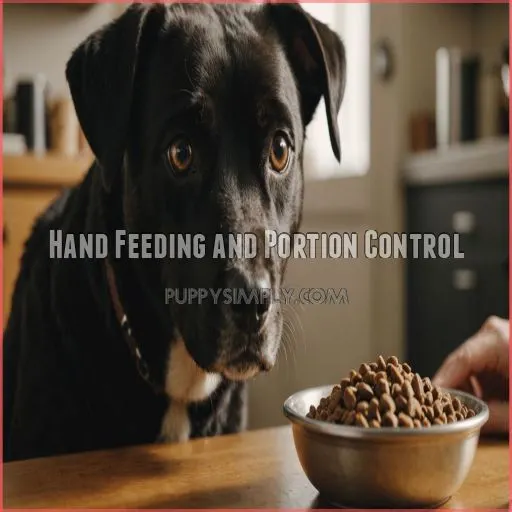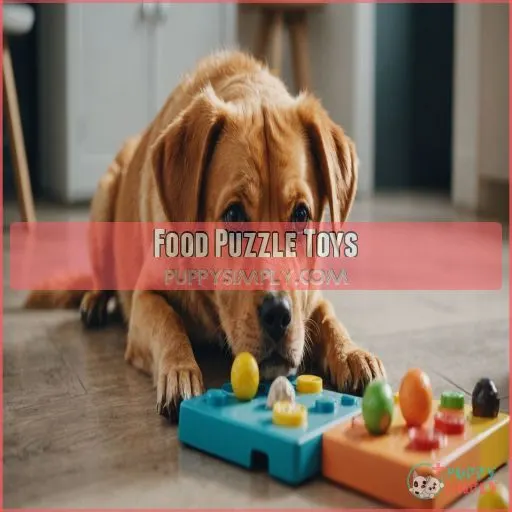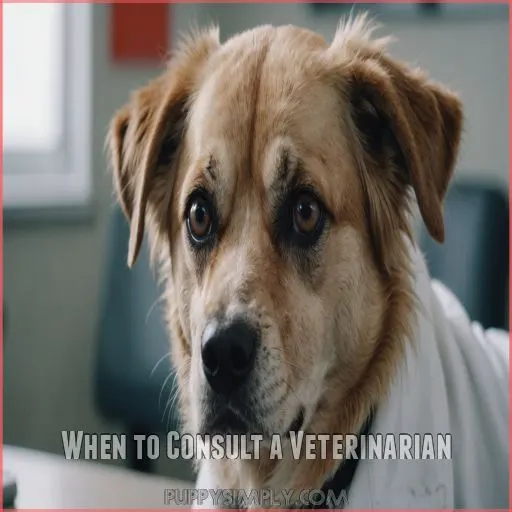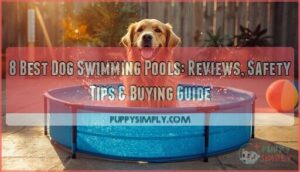This site is supported by our readers. We may earn a commission, at no cost to you, if you purchase through links.
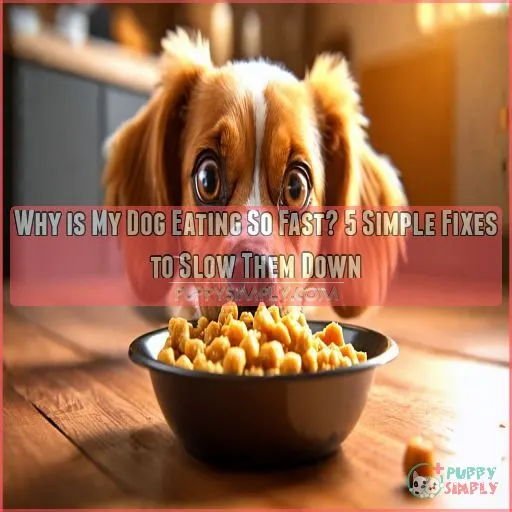
Several factors might be at play: competition with other pets, past food insecurity, or even nutritional deficiencies.
It’s like they’re in an all-you-can-eat race!
While it might seem harmless, rapid eating can lead to choking, bloat, or digestive issues.
Luckily, you can slow down your speedy eater with puzzle bowls, DIY solutions, or even hand feeding.
Remember, your pup’s dining habits might be telling you something important about their health or environment.
Stay tuned for some clever tricks to turn your dog’s mealtime marathon into a leisurely feast!
Table Of Contents
- Key Takeaways
- Signs Your Dog is Eating Too Fast
- Reasons Behind Your Dog’s Rapid Eating
- Potential Dangers of Fast Eating
- Effective Methods to Slow Down Eating
- When to Consult a Veterinarian
- Frequently Asked Questions (FAQs)
- Why does my dog eat so fast?
- Why does my Dog Eat Too Fast and then vomit?
- Can a dog eat too fast?
- How can I slow down a dog that eats too fast?
- What does it mean when your dog eats fast?
- How can I slow down my dogs eating speed?
- Why do dogs eat in a hurry?
- Why does my dog always eat like he’s starving?
- Can fast eating affect my dogs digestive system?
- Are certain dog breeds more prone to eating quickly?
- How long should it take for a dog to finish a meal?
- Does the type of food impact eating speed?
- Can fast eating lead to behavioral issues in dogs?
- Conclusion
Key Takeaways
- Your dog’s rapid eating can stem from competition with other pets, past food insecurity, or nutritional deficiencies – it’s not just bad manners, and you’ll need to identify the root cause to address it effectively.
- Fast eating poses serious health risks for your pup, including choking, bloat (gastric dilatation-volvulus), and digestive issues – you shouldn’t ignore this behavior as it can lead to life-threatening conditions.
- You’ve got multiple options to slow down your dog’s eating, from puzzle bowls and slow feeders to DIY solutions like muffin tins – experiment to find what works best for your pet’s specific needs.
- If your dog continues to eat rapidly despite using slow-feeding techniques, or if you notice sudden changes in eating behavior, you’ll want to consult a vet to rule out underlying health conditions.
Signs Your Dog is Eating Too Fast
Is your pup wolfing down their dinner like there’s no tomorrow?
Keep an eye out for these telltale signs of fast eating.
You might notice food flying as your dog dives in, or hear snorting and gasping for air between bites.
If they’re swallowing whole chunks without chewing, that’s a red flag.
Watch the clock – if your furry friend finishes their meal in under 2 minutes, they’re likely eating too quickly.
These habits can lead to tummy troubles, so it’s important to spot them early.
Don’t worry, though – we’ve got solutions to help your speed-eater slow down.
Reasons Behind Your Dog’s Rapid Eating
Your dog’s rapid eating habits can stem from various factors, ranging from competition with other pets to underlying health issues.
Understanding these reasons is key for addressing the behavior and ensuring your furry friend’s well-being.
Competition With Other Pets
Your dog’s rapid eating might stem from a competitive instinct in multi-pet households.
It’s as if they’re racing to finish first, ensuring they get their fair share before another furry friend swoops in.
This wolf-like tendency can lead to a "fastest eater wins" mentality.
In these cases, feeding pets separately or using puzzle feeders can help curb the competition and slow down mealtime, reducing the risk of bloat (Source).
Past Food Insecurity
While other pets might spark competition, past food insecurity can leave lasting scars on your furry friend’s eating habits.
Dogs with a history of neglect or shelter life often wolf down their meals, fearing it might be their last.
This behavior stems from a deep-rooted survival instinct, not greed or bad manners.
Here are five signs your dog may have experienced food insecurity:
- Guarding food bowls or stealing human food
- Eating non-edible items (pica)
- Obsessively checking empty food bowls
- Becoming anxious around mealtimes
- Difficulty responding to commands when food is present
Nutritional Deficiencies
Sometimes, nutritional deficiencies can drive your dog to gulp down food like there’s no tomorrow.
A balanced diet is key for your pup’s health, but certain foods may lack essential nutrients.
If you notice signs like a dull coat or excessive shedding, it’s time to reevaluate your dog’s nutrition.
Consider high-quality dog food, supplement options, or consulting your vet to make sure your furry friend’s nutritional needs are met.
Underlying Health Conditions
Beyond nutrition, health issues can drive rapid eating.
Conditions like Cushing’s syndrome or diabetes may increase your pup’s appetite.
If Fido’s suddenly become a furry vacuum cleaner, it’s time for a vet visit.
They’ll check for sneaky culprits like parasites or thyroid problems.
Don’t brush off changes in eating habits – they’re often the canary in the coal mine for underlying medical causes.
Potential Dangers of Fast Eating
Your dog’s speedy eating habits aren’t just messy—they can be dangerous.
Fast eating can lead to choking, vomiting, and even life-threatening conditions like bloat.
So it’s essential to address this behavior for your pup’s health and safety.
Choking and Vomiting
With lightning-fast eating, your furry friend’s putting themselves in harm’s way.
Choking hazards aren’t limited to fast eating, they can also come from certain foods like walnuts that pose a choking risk. Choking hazards lurk in every mouthful when dogs gulp without chewing.
You might hear that heart-stopping "Ack ack" sound as food gets lodged in their throat.
Vomiting’s another unwelcome guest at this speed-eating party, often making an appearance right after meals.
To keep your pup safe, consider slow feeding bowls or hand feeding to put the brakes on their dining dash.
Bloat and Gastric Dilatation-Volvulus
Rapid eating isn’t just a choking hazard; it can lead to a life-threatening condition called bloat or gastric dilatation-volvulus (GDV).
You should address this issue, as it’s also linked to various underlying health issues such as diabetes, Cushing’s disease, or parasites that can increase appetite why is my dog eating so fast.
This serious issue is especially risky for deep-chested breeds .
GDV occurs when:
- The stomach fills with air
- Pressure builds, stopping blood flow
- The stomach flips, cutting off circulation
- Organs are deprived of oxygen
Don’t panic, though! You can reduce the risk by using slow feeder bowls or food puzzle toys.
Discomfort and Digestive Issues
Your furry friend’s fast eating can lead to more than just a messy floor.
It’s a recipe for digestive upset and stomach pain.
When dogs gulp down food, they swallow air, causing discomfort and potential gastrointestinal health issues.
This rapid eating can trigger vomiting, bloating, and even food allergies.
When it comes to selecting a bowl, consider your dog’s eating habits and check out the best dog bowls that can help slow them down. To keep your pup’s tummy happy, consider using a dog food puzzle or slow feeder bowl.
Your pet’s health is worth the extra effort!
Effective Methods to Slow Down Eating
If your dog’s eating habits are more vacuum than canine, and they’re not showing much interest in their regular meals, you might want to try some proven tricks for picky pups. It’s time to put the brakes on their rapid dining.
You’ll find several effective methods to slow down your furry friend’s eating, from puzzle bowls to DIY solutions, that can make mealtime safer and more enjoyable for your pet.
Puzzle Bowls and Slow Feeders
Puzzle bowls and slow feeders are clever tools to put the brakes on your pup’s speedy eating habits.
These specially designed dishes, like the "Broken Wave" structure, create obstacles that make your dog work for their meal.
It’s like turning dinner into a game of hide-and-seek!
These bowls can slow down eating by up to 15 times, giving your furry friend’s tummy time to catch up with their appetite.
DIY Solutions (Cookie Sheets, Muffin Pans)
Ingenious DIY slow feeders can turn mealtime into a puzzle for your pup.
Transform everyday items into canine brain teasers:
- Muffin tin magic: Flip it upside down and scatter kibble between the cups.
- Cookie sheet challenge: Spread food across a large sheet, making your dog work for each bite.
- Cardboard tube trick: Create a treat-dispensing toy by poking holes in a tube.
These simple hacks slow down eating, boost mental stimulation, and keep your furry friend entertained.
Hand Feeding and Portion Control
Looking for a hands-on approach? Hand-feeding your pup can work wonders. It’s like a doggy dinner date that slows down their eating and strengthens your bond.
Break their meal into smaller portions throughout the day to keep their tummy happy.
As a bonus, you can use their regular food as training rewards. It’s a win-win: they learn new tricks while savoring every bite.
Food Puzzle Toys
For a fun twist on mealtime, try food puzzle toys.
These clever gadgets challenge your pup’s mind while slowing down their eating, much like stuffing a Kong toy with treats to keep them engaged.
You can fill these puzzle toys with a variety of foods, such as kibble or even canned fish, similar to Kong dog toys review.
From simple ridged bowls to more complex mazes, there’s a puzzle for every pooch (Source).
You’ll see benefits like mental stimulation and reduced boredom .
Start with easier puzzles and gradually increase difficulty.
Remember, safety first – choose toys appropriate for your dog’s size and chewing habits.
When to Consult a Veterinarian
Despite your best efforts, sometimes your pup’s rapid eating habit persists.
It’s time to consult a vet when:
- Your dog continues gulping food, even with slow-feeding techniques
- You notice recurring digestive issues or vomiting after meals
- There’s sudden changes in eating behavior or appetite
- You suspect underlying health conditions like Cushing’s disease or diabetes
Don’t let your furry friend’s fast dining turn into a doggy health drama. A vet check-up can rule out medical reasons for speedy eating and address bloat concerns. They might suggest diet tweaks or additional strategies to keep your pooch’s dining pace in check. Remember, it’s better to be safe than sorry!
Frequently Asked Questions (FAQs)
Why does my dog eat so fast?
Your dog’s fast eating could stem from competition anxiety or a wolf-like instinct.
It might also indicate health issues like parasites or hormonal imbalances.
Try spreading out meals or using puzzle bowls to slow them down (Source).
Why does my Dog Eat Too Fast and then vomit?
Like a vacuum cleaner on overdrive, your dog’s speedy eating can lead to trouble.
Gulping food and air causes stomach expansion, discomfort, and potential vomiting.
Competition, habits, or medical issues might be the culprits.
Slow down mealtime to prevent this messy situation.
Can a dog eat too fast?
Dogs can definitely eat too fast, which can lead to health issues.
You’ll want to watch out for choking, vomiting, and even bloat.
It’s like they’re in an eating race!
Consider using slow-feeder bowls or puzzles to pace their meals.
How can I slow down a dog that eats too fast?
Tame the food tornado by using slow-feeder bowls or puzzle toys.
Spread kibble on a snuffle mat or add water to their bowl.
Feed in separate rooms for multi-pet households.
You’ll safeguard their health and make mealtime a brain game.
What does it mean when your dog eats fast?
Your pup’s fast eating could signal underlying anxiety or competition learned as a puppy.
It’s not just bad manners – your furry friend might’ve developed this habit when competing with littermates for food.
How can I slow down my dogs eating speed?
Like a race car needs speed control, speedy eaters need smart solutions.
Try spreading kibble on a cookie sheet, using puzzle feeders, or adding water to food.
You’ll transform meals from NASCAR to leisurely dining.
Why do dogs eat in a hurry?
Dogs often race through meals due to their competitive instincts, thinking they’re racing against others for survival.
Health issues like parasites can also drive rapid eating by increasing hunger and disrupting fullness signals.
Why does my dog always eat like he’s starving?
Rapid eating often stems from survival instincts or medical conditions.
You’ll need a vet to pinpoint the cause – it could be stress, learned behavior, or health issues like diabetes.
Don’t ignore this behavior; it warrants professional attention.
Can fast eating affect my dogs digestive system?
Your pup’s speed-eating can lead to choking, vomiting, and digestive issues like gas and bloat.
When food rushes through their system three times faster than yours, it’s a recipe for tummy trouble!
Are certain dog breeds more prone to eating quickly?
Large-breed and deep-chested pups often eat faster than others. You’ll notice this especially in Great Danes, Standard Poodles, and German Shepherds. It’s like they’re racing to finish their dinner first!
How long should it take for a dog to finish a meal?
Dogs should take about 15 minutes to finish their meal.
This helps establish healthy eating habits.
You’ll want to set a timer and remove any uneaten food when it goes off.
Does the type of food impact eating speed?
Food consistency matters a lot.
Kibble can be gulped quickly, while spreading it on a cookie sheet forces slower eating.
Try using muffin pans to portion meals – it’s like creating a puzzle that’ll make mealtime last longer.
Can fast eating lead to behavioral issues in dogs?
Ever wonder why your furry friend’s speed-eating matters?
Actually, it’s the other way around – behavioral issues like anxiety or resource guarding can cause rapid eating.
You’ll need to address these underlying concerns for healthier habits.
Conclusion
Based on research, a dog eating too fast isn’t just a quirky habit – it’s often a sign of deeper issues that need addressing.
By understanding why your dog is eating so fast and implementing the right solutions, you can make mealtimes safer and more enjoyable for your furry friend.
Whether you choose puzzle bowls, DIY fixes, or seek vet advice, taking action now prevents potential health problems later.
Remember, every dog is unique, so be patient as you find the perfect method to slow down your speed-eating pup.

